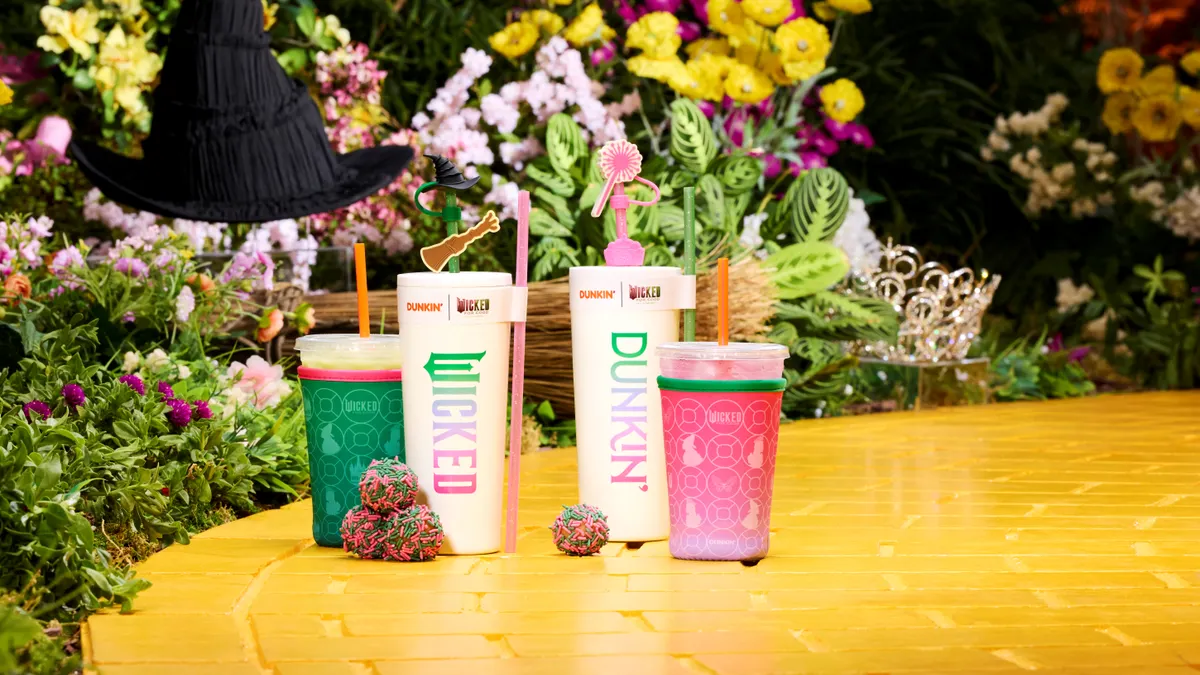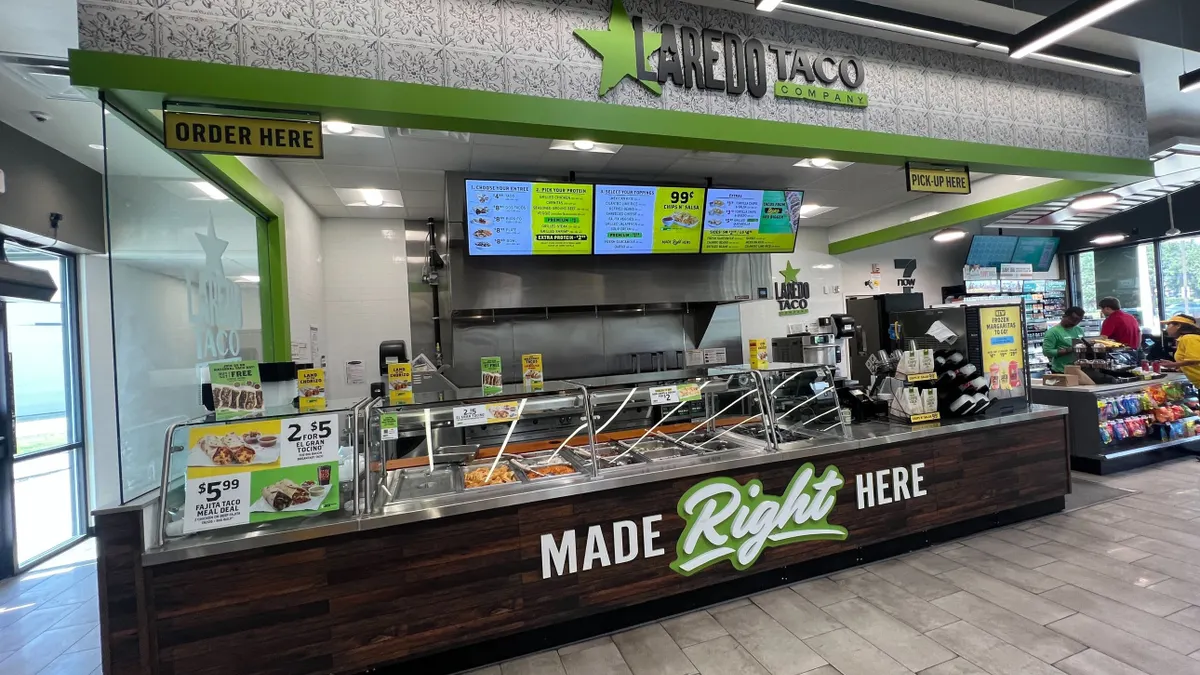Convenience stores like Twice Daily in Tennessee are a growing threat to the restaurant industry, stealing a share of stomach from the QSR and fast casual space in particular, Frank Beard, an analyst at GasBuddy, told Restaurant Dive at the NRA Show.
Twice Daily has the trappings of a typical convenience store. Snacks, beverages and grab-and-go meals stack the shelves. But Beard says you need to walk inside to see how its aesthetic differs from the typical c-store. Long hardwood panels line the floor as wide windows let natural light pour in. Customers are greeted with wide aisles, built-in refrigerators spanning the perimeter and the brand’s own coffee bar, White Bison.
Saddle up to the high-top seats and get on the fast Wi-Fi. Enjoy third-wave, single-origin pour over coffee built into the marble countertops, as industrial Edison bulb lighting hangs from the ceiling. There’s not a gas pump in sight. This is the new c-store experience.
"By and large, there's sort of this perfect storm right now where, for years, the industry was relying unofficially on this model of 'Cokes, smokes and gas' where you’d have retailers selling fuel, having an interchangeable store offering from one store to the next," said Beard.
But fuel margins are thinning out and more people are shunning tobacco as better-for-you becomes the new catchphrase. Most of all, modern life is lived on the go. In 2016, the share of money being spent on food purchases outside of the home actually eclipsed what consumers were spending to eat inside their homes, Beard said. Convenience stores had to evolve. Enter foodservice.
"Yes, we're a convenience store, but we think of ourselves as a restaurant-to-go."

Chris Gheysens
President and CEO, Wawa
Early adopter Wawa began offering its cult-favorite sandwiches in the mid-90s, but most have only started to shift into the segment. "I’d really say it's been within the past 10 years that you've seen this trend, full steam ahead," said Beard.
In fact, during the keynote session on the future of dining at the NRA Show, Wawa CEO Chris Gheysens said, "Yes, we're a convenience store, but we think of ourselves as a restaurant-to-go."
That should put restaurants on watch. Competition for consumers is already saturated, with many traditional dining options aggressively pursuing expansion. Last week, Burger King announced plans to open more than 40,000 new locations by 2029, surpassing McDonald's current store count. And just yesterday, MOD Pizza said it would more than double its footprint to 1,000 restaurants in the next five years.
But now, restaurants have a new crop of competitors to consider; they need to battle the 7-Elevens, Sheetz and Wawas of the world. The National Association of Convenience Stores' State of the Industry report found that 23% of convenience store sales come from foodservice. In a separate study, GasBuddy found that 43% of Americans age 18-29 bought more convenience store meals than they did three years prior, and as more focus on modernizing their offerings, they're likely to continue siphoning dollars from their QSR counterparts. Why go to Taco Bell if you can visit 7-Eleven's taqueria and also pick up a few groceries while there?
Foodservice as a growth vehicle
For Wawa, dropping its partnerships with chains, including Taco Bell, Pizza Hut and Dunkin' Donuts, in the '90s to develop its own products was just one of many steps to become the foodservice giant it is today. "It's really been an evolution of foodservice as a growth vehicle for us," Mike Sherlock, Wawa's chief product marketing officer, told Restaurant Dive.
Today the company sounds a lot like a restaurant, with test kitchens and a sensory lab for product tasting. On staff are culinarians, master coffee roasters, nutritionists and food scientists on the corporate level. It also fully rolled out a custom salad program earlier this month after a pilot in Florida last year and the mid-Atlantic over the last six months, Sherlock said.
Sheetz has a popular menu as well, from its Boom Chicka Mac to its Walker Breakfast Ranger sandwich, and its touchscreen ordering system lets consumers customize their meals.
The growth of larger companies like Sheetz and Wawa aren't the only threats to restaurant traffic. According to CSP Daily News, 62% of convenience stores are single stores. "That’s one thing that has made convenience stores more agile and more able to fill this space quicker," said Jackson Lewis, assistant editor at Winsight Media, during an NRA Show panel. They can make decisions faster, which means more innovation, without all the red tape.
"In every community, you'll see these single stores that are doing something absolutely outrageous with foodservice," said Beard. "If you're from Kansas City, probably the best Mediterranean food is from [c-store] Papu's Cafe."
Grinding up the coffee competition
With every good breakfast sandwich comes coffee, and this segment may be where restaurants are really losing ground. Lewis cited data from Technomic that showed that among the top 20 coffee programs in the past year, regional convenience store Cumberland Farms ranked fourth, beating out Dunkin'. That’s a hit to the Dunkin' brand, which announced last September it was dropping "Donuts" from its name to focus on its beverages, particularly coffee, which constitutes 60% of its U.S. sales.
"If the coffee brands aren't paying attention to this, they should be. They are being eclipsed by some of these convenience store brands that are pulling ahead with these coffee offers that, speaking purely as a consumer, I don't think they can compete with."

Frank Beard
Analyst, GasBuddy
"If the coffee brands aren't paying attention to this, they should be," Beard told Restaurant Dive. "They are being eclipsed by some of these convenience store brands that are pulling ahead with these coffee offers that, speaking purely as a consumer, I don't think they can compete with."
The coffee segment already has some heavy hitters, including Starbucks and Peet's Coffee, as well as thousands of independent brands. In the U.S., there are now more than 35,000 shops, with even more entering the field vying for a part of the $45.4 billion market, Beverage Daily reported. Godiva, for example, plans to open 6,000 cafes in the next six years. Coffee drinkers have their choice, and restaurants and c-stores alike will have to step up if they want the foot traffic.
While many convenience stores, like White Bison, are drawing in the java junkies, there are others in the c-store space who still offer the stereotypical gas station coffee, Beard noted. The quality of their coffee is unpredictable and the experience forgettable. "If you can't give them a good enough coffee offer, you might lose them to a Starbucks or a Dunkin' Donuts," he said.
Speed versus experience
Despite the inroads convenience stores have made to improve their foodservice, QSRs and fast casuals, in general, have an advantage in customer experience and menu innovation.
"It's no secret that there is a reputation for gas stations for being dirty. That is a reputation that's hard to shake. Often just having fuel pumps outside a store will contribute to negative connotations," said Beard. "If a customer sees a dirty restroom or a dirty store, that's a litmus test for everything else and that’s going to reflect very poorly on their foodservice."
It doesn't help if tables are left dirty, often because convenience store employees aren't trained to be foodservice employees. The distinction is an important one, says Beard, because what comes naturally to a waiter won't to a person who mans the counter.
As for the food, many are still offering the usual fare — think premade turkey sandwiches — found at any convenience store.
What convenience stores are experts in, however, is speed. When Beard did a five-day experiment in five different areas of Des Moines, he tested the time it took him to leave the road, buy a breakfast sandwich and get moving again. He visited three convenience stores and three QSRs each morning.
"The drive-thrus were considerably slower than the convenience store. Not even close. We have this perception that drive-thrus are a fast way to get food, but in many cases, we’re all noticing how long the lines are," he said. "If [QSRs] are able to focus on speed of service, but also present a welcoming and 'wowable' experience, then they're going to be in a much better position to compete."
McDonald's has zeroed in on this quickly after being named the slowest against its top competitors. In March, CFO Kevin Ozan talked about the company's priority to shorten drive-thru time so that meals arrive hot to its customers.
On the off-premise bandwagon
Similar to restaurants, many convenience stores are finding their footing with off-premise — delivery in particular.
Wawa continues to lead the space, launching catering in all of its more than 840 stores earlier this month. Sherlock also highlighted its catering kitchen in Philadelphia, with plans to expand the concept to other markets at a later date.
With delivery, the company uses third-party services, including Uber Eats and Grubhub, but is testing its own delivery to complement its current partnerships, Sherlock said. Right now, Wawa is setting up the platform and ensuring it complements the in-store experience.
Why create its own delivery platform? Sherlock’s answer honed in on data. "The best way to maintain a close personal relationship with customers and know what their needs are in the delivery environment is to really own the data. And the best way to do that is through a self-delivery model," he said.
And Wawa isn't alone. During his panel, Lewis noted there are companies whose business models are built on going to convenience stores and teaching them how to create their own delivery business. Beard also noted that there were a few independents experimenting as well.
Lewis said, "They’re learning how to do these things in-house. The industry is slowly realizing that in today's 'need-it-now' market you need to not only be a foodservice company, but you need to be a technology company, a logistics company."
This concept is nothing new to the restaurant industry. Domino’s has long dubbed itself "a tech company that sells pizza," coming up with innovations like its Hotspots and GPS delivery tracking. Across the NRA Show floor this year, the booths were scattered with tech platforms to capture customer data, improve workflow management and streamline ordering. The massive tech corridor at the conference was indicative of the larger foodservice industry.
"With c-stores being within about a mile from every home in America, they are sitting on the most powerful distribution network in the entire country. And they have yet to tap into it."

Jackson Lewis
Assistant editor, Winsight Media
But just because delivery is the next big thing, doesn’t mean every concept should try it. "Convenience is really a mixed bag on delivery, and I don’t think there's a clear answer on that one,” said Beard. “Convenience stores are the perfect place to deliver food service because … they occupy the best corners, the best streets in every community around the United States. It’s an industry that really owns the last mile in retail."
Some brand don't have the margins to support a foodservice program, though. It's very individual, Beard said, and some are opting out.
If convenience stores do figure out how to successfully optimize delivery though, the potential impact on restaurants could be huge. According to an NACS report, 93% of the country lives within 10 minutes of a convenience retailer.
"With c-stores being within about a mile from every home in America, they are sitting on the most powerful distribution network in the entire country," Lewis said. "And they have yet to tap into it."

















